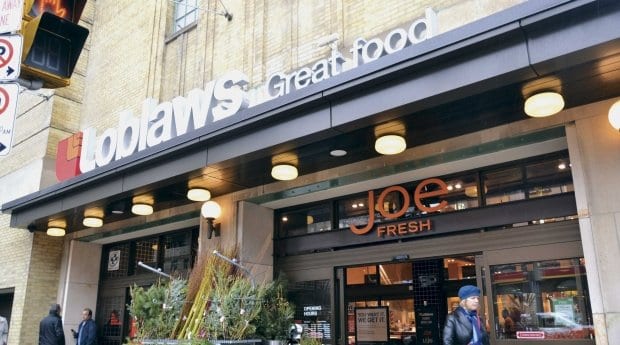
Since it opened in November 2011, the Maple Leaf Gardens Loblaws has factored into many conversations about the changing face of the Church-Wellesley neighbourhood. Credit: Andrea Houston
“For your information, dink, Social Safeway just happens to be … well,
it’s just the … big thing, that’s all.”
“For those who get off on groceries.”
“For those who get off on
men, hon. It’s a local tradition.
Every Wednesday night.”
In Armistead Maupin’s Tales of the City series, the Marina Safeway is a grocery store envisioned with all the excesses of the Me Decade — a space of free love and social experimentation that had evolved well beyond its utilitarian roots. There, shopping for groceries took a backseat to social interaction, with singles cruising the aisles and dancing to disco and the promise of young love around every display case.
Maupin’s Safeway may seem like a relic from a bygone era, but retail spaces remain popular cruising spots for many gay men. A quick skim through Craigslist’s missed connections reveals that Toronto is still a hotbed of public cruising, with retail spaces like the food court at the Eaton Centre and the Maple Leaf Gardens Loblaws particularly high on the list.
So, while you might not make friends with salad, there’s a good chance you’ll find other forms of intimacy while shopping for one.
“With the advent of dating lines, then websites, then phone apps, the need for a geographical location in which to cruise has decreased, but there will probably always be people who prefer to go to a park or store to cruise,” says columnist Jeremy Vance Willard, one half of Xtra’s History Boys. “Whether because that’s what they’re used to or because it’s dangerous and fun or they just feel naughty wandering around a grocery store or clothing store eying up random guys. Maybe it’s more visceral or real than using an app.”
Since it opened in November 2011, the Maple Leaf Gardens Loblaws has factored into many conversations about the changing face of the Church-Wellesley neighbourhood. For some, the big-box retailer’s presence has been a sign of the gentrification of the Village, with independents slowly being driven out by higher rental costs and excessive condo construction. Others have viewed the grocery chain as part of a larger process of urban renewal, with a decaying landmark smartly reconfigured to better serve the surrounding community.
Either way, patrons seem to have embraced the space. The location has done brisk business in its first two years and continues to attract a significant amount of foot traffic. And in an interesting throwback to Maupin’s era of grocery shopping, the store was designed to encourage socializing.
“We absolutely see it as a meeting place,” says Mark Landini, creative director of Landini Associates, the graphic and interior design firm hired to shape the look of the store. “In fact, our aim was to create a modern version of a market town square — a social hub for the community, providing a place to meet, eat and fall in love. A place to sample, watch and be inspired by the food and … where people could slow down, browse and learn as well as switching off and socializing.”
Landini explains that urban planners didn’t give his firm guidelines so much as “guiding principles” dictated by the building’s history and overall layout. Eschewing a more standard museum-style approach with cordoned-off sections, the firm instead chose an integrated design, with a mixture of materials commonly used in urban spaces and a shaded lighting system that could emphasize products while preventing the harsh fluorescent lighting of other food shops. The overall effect was meant to recreate the impression one has in an outdoor space or city street.
“We wanted the light and shade that one finds in nature, thus providing and encouraging a slower pace than normal so that customers would be more likely to slow down and enjoy and engage with the store … Certainly, it was our desire to create a social space,” he says.
For some patrons, the invitation to slow down, enjoy and engage has been taken to new heights.
“I’ve definitely had successful hookups at the Loblaws, but it makes a lot of sense if you think about it,” says Marcus, a bisexual man who spoke to Xtra on condition of anonymity. He regularly cruises a number of public spaces in the city, including the Eaton Centre, the University of Toronto and the Maple Leaf Gardens Loblaws. And what attracts him to those specific places is pretty clear.
“Well, proximity to other men is a big part of it. Somewhere like [Maple Leaf Gardens] is near the Village, so you’re more likely to find people looking for sex … The other is a mixture of private and public space. You want somewhere that attracts many different types of men and that [can allow for] privacy and discretion but where you can also be safe if the situation is dangerous.”
A grocery store is a daily stop in many people’s lives, he notes, whether they’re partnered or not. “Everyday tasks can be very attractive to some men. It’s a place where you can go and get off without the stigmas or questions.”
For Willard, retail spaces have always been a common space for cruising. “In Toronto in the ’20s and ’30s, retail spaces were certainly one of the main places to go to find other gay guys. Especially the Eaton Centre or Simpsons — they were places where gay people worked, and stores like that were relatively tolerant places.”
But, Marcus warns, that tolerance goes only so far.
“You have to be careful. The store may encourage the public to visit and socialize, but it’s still private property. They want you to [patronize] their store, and there are still very strict laws around public sex.”
Which isn’t to say that men who are looking for sex are limited in their options.
“There’s no end of historical incidences where guys have found secluded and poorly policed places where they could hook up, from British molly houses in the 18th century to NYC’s The Bowery in the late 19th century to parks just about any place and at any time,” Willard says.
“If there’s no handy place to hook up, people create them.”

 Why you can trust Xtra
Why you can trust Xtra


